Multiplication Charts (86)
Published on February 22, 2021 / Last modified on September 26, 2023
Multiplication Charts, also called Times tables Charts, are essential tools to learn the multiplication tables! To help you in this task, we offer you many Printable multiplication charts. They are in A4 standard format, available as free PDF files to download. Once you have printed the Chart, you can post it on the wall near your desk or put it into your school bag. You will find on this page:
- Different sizes of charts: Chart from 1 to 10 (10x10), Chart from 1 to 12 (12x12), Chart from 1 to 15 (15x15) or Chart from 1 to 20 (20x20). Choose the one that suits your needs!
- Complete Charts or Blank Charts to be filled in: Complete charts are for learning the multiplication tables (or as a memory aid), while blank chart to be filled in are ideal for practice the Times tables.
- Colorful or black and white Charts: A colorful chart will help you remember more easily. You can also choose your own colors by coloring a black and white chart.
Feel free to see our Tricks for learning your Times tables Chart. If you are just starting out, please read How to read a multiplication Chart?
Don't hesitate to take a look at The Pythagorean Table | How to read a multiplication Chart ? | How to learn a multiplication Chart ? | Tricks for each times table | Practice your Multiplication tables
Thanks to this interactive online multiplication chart, easily find the result of a multiplication! To do so, simply hover over the chart with your mouse (or just touch a cell with your finger if you are using a tablet or smartphone). It's an Easy-to-use tool to make math more fun!
Moreover, you can change the look and the size of the chart thanks to the many customization options available. We offer you several themes: Minecraft decor, animals, underwater landscape, Halloween atmosphere and many others to discover...

Times tables charts (2 PDF to cut and assemble)
A pretty chart with all the times tables to print in A4 format (PDF). We have assigned a different color code for each times table, with a nice color gradient. The colors will help you memorize all your multiplication tables from the 1 to the 12 times table (other colors are available for this resource).
Origin: The Pythagorean Table

It was Pythagoras, a renowned mathematician and philosopher from ancient Greece, who came up with the idea to organize the multiplication tables within a chart, hence the name « Pythagorean Table » often used to refer to the Multiplication tables Chart. The Pythagorean table is very useful for quickly finding the result of a multiplication.
Born around 570 BC, he is best known for Pythagoras' theorem, which states the relationship between the lengths of the sides of a right-angled triangle. Pythagoras is often referred to as "Pythagoras of Samos" to indicate his birthplace, the island of Samos, a Greek island located in the Aegean Sea. This island contributed to the intellectual and cultural environment of Pythagoras during his youth, but later in his life, he moved to southern Italy where he established his school called Pythagoreanism. He had a significant impact on philosophy, mathematics, and science.
*The illustration opposite was isolated from a photo of the giant fresco "The School of Athens" by the Italian painter Raphael.
How to read a multiplication Chart ?
To find the result of a multiplication, simply look for the intersection between the horizontal row of the first digit of the multiplication and the vertical column corresponding to the second digit. You can use your finger to help by sliding it along the row to the intersection point.
Let's take an example: What is the result of the multiplication 7 x 6 ?
- 1- Locate in the table the horizontal row corresponding to the first number (digit 7 in this example)
- 2- Then, locate the vertical column corresponding to the second digit (digit 6 in this example)
- 3- The result of the multiplication is found in the square at the intersection: the multiplication of seven by six equals 42.
You will notice that if you do the same thing for the multiplication 6 x 7 you will find the same result at the intersection, indeed 6 x 7 = 7 x 6. This is what we call the commutative property of multiplications!
Step-by-step method for reading a Multiplication Chart
-
![How to find the result of 7 x 6? How to find the result of 7 x 6?]() How to find the result of 7 x 6 ?
How to find the result of 7 x 6 ? -
![Locate the horizontal row corresponding to 7 Locate the horizontal row corresponding to 7]() Locate the horizontal row corresponding to 7
Locate the horizontal row corresponding to 7 -
![Locate the vertical column corresponding to 6 Locate the vertical column corresponding to 6]() Locate the vertical column corresponding to 6
Locate the vertical column corresponding to 6 -
![The result is at the intersection, so 7 x 6 = 42 The result is at the intersection of the 2 lines, so 7 x 6 = 42]() The result is at the intersection, so 7 x 6 = 42
The result is at the intersection, so 7 x 6 = 42
Commutative property of multiplication
Your math teacher must have told you about the commutative property of multiplication. This simply means that, regardless of the order of the numbers in a multiplication, the result will be the same!
Commutativity of Multiplication:
a x b = b x a
To illustrate this property, we compared the results of 7 x 6 and 6 x 7 in a multiplication chart. You'll notice that the result at the intersection of 7 x 6 is identical to that of 6 x 7.
Note: This property applies in the same way regardless of the number of factors, for example: 2 x 3 x 4 = 2 x 4 x 3 = 4 x 3 x 2 = ...
The diagonal of the chart or Square numbers
The diagonal of the multiplication table is formed by the cells where the row number equals the column number. The numbers on the diagonal represent the square numbers. A square number is the result of a multiplication where the number is multiplied by itself. For example, 36 is the square of the number 6 because 6 x 6 = 36. In terms of notation, 6 x 6 is equivalent to 6². Verbally, 6² is pronounced as "6 squared" or "6 to the power of 2", it means the same thing.
A square of numbers:
a x a = a²
To illustrate this, we have chosen a colored chart to help you visualize the diagonal. In this example, the diagonal starts from the top left at the number 1 (the square of 1) and goes down to the bottom right at the number 144 (the square of 12).
In a 12x12 multiplication chart,
the square numbers are:
- 1 x 1 = 1² = 1
- 2 x 2 = 2² = 4
- 3 x 3 = 3² = 9
- 4 x 4 = 4² = 16
- 5 x 5 = 5² = 25
- 6 x 6 = 6² = 36
- 7 x 7 = 7² = 49
- 8 x 8 = 8² = 64
- 9 x 9 = 9² = 81
- 10 x 10 = 10² = 100
- 11 x 11 = 11² = 121
- 12 x 12 = 12² = 144
How to learn a multiplication Chart ?
When you first see a multiplication chart, the number of multiplications it contains can seem daunting. But rest assured, it's not! With a few tips and tricks, you'll realize that there are only a few multiplications to memorize by heart.
Bring colour into your Chart !
Adding color to a table not only brightens up your homework and math classes but, more importantly, it will help you with memorization, especially if you have a predominantly visual memory.
We offer 3 solutions:
- You can create a custom chart with your favorite colors. In this case, print a Black and White Multiplication Chart and get your markers or pencils ready!
- To save time, you can choose a ready-made table that's already colored from our Printable Multiplication Charts 10x10 or Multiplication Charts 12x12.
- Another option is to use this interactive Online multiplication table that you can hover over with your mouse. It's customizable with many options, and for more fun, you can even change the background scenery!
Here are some tips for adding color to your chart:
Color the cells of the table using your favorite colors! Choose a different color for each of the times tables, this is what we call a color code. This color will be used both vertically and horizontally.
Let's take a concrete example:
If you assign green to the number 3, you should color the following cells in green: 3x3, 3x4, 3x5, 3x6, 3x7, 3x8, 3x9 (horizontal row) as well as 4x3, 5x3, 6x3, 7x3, 8x3, 9x3 (vertical column). As 3x2 belongs to the 2 times table, color it with the color of the 2 times table. The result of 3x2 is equal to the result of 2x3, so it's unnecessary to learn both. When you know the result of the first multiplication, you know the result of the second.
Note: It is not necessary to color the cells corresponding to the 1 and 10 times tables; these multiplications are very easy, and you will remember them without any problem!
No need to learn the whole multiplication Chart
A chart 1-10 (or 10x10), contains 100 squares, so 100 results. It may seem like a lot, but... Great news! You will see that there are many squares that you do not need to learn :) In fact, there are 36 multiplications to know or even only 28 multiplications using tricks. Find below the results of the multiplication chart that you don't need to learn.
1- Don't learn duplicates
As we've already discussed above, thanks to the commutative property of multiplication, there are many equivalent multiplications in a chart (in a multiplication, we can interchange the numbers and still obtain the same result). Thus, we observe symmetry on either side of the diagonal. We can therefore remove all the results below the diagonal.
Once these duplicates are removed, there are only 55 multiplications left and you'll see that we can further reduce this number.
2- No need to learn by heart the 1 and 10 times table
The 1 times table and the 10 times table are the 2 easiest, it is therefore useless to learn them by heart.
1 times Table: A number multiplied by 1 is always equal to the number.
Example: 1x1=1, 1x2=2, 1x3=3, 1x4=4...
10 times Table: A number multiplied by 10 is always equal to the number followed by a zero.
Example: 1x10=10, 2x10=20, 3x10=30, 4x10=40...
And there you have it! You can see that there are only 36 multiplications to learn . That's some good news, isn't it? :)
Note: Don't tell your math teacher, but you can even reduce this number to 28 multiplications if you use the finger trick for the 9 times table.
3- And what about a 12 x 12 chart ?
In a multiplication Chart 1-12, there are 144 results. Once all the duplicates (as well as the 1 and 10 times tables) are removed, there are only 55 multiplications left to know.
Note: Here too, we can further reduce this number because there are tricks for the 9, 11 and 12 times tables. Once the multiplications for these three times tables are removed, there are truly only 28 multiplications to know by heart.
Use tricks for each times table and save time !
As you saw above, in a multiplication chart 1-12, there are 55 multiplications to know. Thanks to our tricks for each times table, you'll memorize them more quickly and save a lot of time!
-
![Trick for the 5 times table Trick for the 5 times table]() 5 times table
5 times table -
![Trick for the 6 times table Trick for the 6 times table]() 6 times table
6 times table -
![Trick for the 7 times table Trick for the 7 times table]() 7 times table
7 times table -
![Trick for the 8 times table Trick for the 8 times table]() 8 times table
8 times table -
![Trick for the 9 times table Trick for the 9 times table]() 9 times table
9 times table -
![Trick for the 10 times table Trick for the 10 times table]() 10 times table
10 times table -
![Trick for the 11 times table Trick for the 11 times table]() 11 times table
11 times table -
![Trick for the 12 times table Trick for the 12 times table]() 12 times table
12 times table
Practice your multiplication tables
Don't forget to practice your Multiplication Tables. Reviewing the tables is an essential step for long-term memorization but, don't worry, below we offer you several cool tools to practice your tables. Don't hesitate to try several tools and choose your favorite one.
1- Practice with online times tables games
At last, a fun and motivating way to practice the times tables without getting bored! Our multiplication games are highly effective for memorizing the tables. They will allow you to progress quickly, and what's more, to motivate you, your efforts will be rewarded with surprise games included in the main game.
2- Practice with online multiplication tables exercises
Try our online exercises, a simple and effective revision method! The progress bar located above the exercise shows you where you are in the series and the number of mistakes you have made. Below the exercise, your most frequent errors are displayed, which will allow you to know the multiplications that still challenge you.
Choose the multiplication table you want to practice with:
3- Use multiplication Flash cards
You may have already heard of Flash Cards. These are cards with a question on the front and the answer on the back. Here, the question will be the multiplication, and the answer will be the result of this multiplication. We offer you multiplication table flashcards that you can use as a game. These cards will help you quickly memorize your tables while having fun with your friends.
4- Fill in a Blank multiplication Chart
To practice your times tables, you can also fill in a blank (or empty) multiplication chart This is also an effective technique for long-term memorization of the tables. We offer you a wide selection of printable blank charts (PDF) in A4 format.
5- Print multiplication worksheets
The use of dedicated worksheets for multiplication tables proves to be an effective and proven learning method. The worksheets are specially designed to target specific multiplication tables. This will allow you to focus on one table at a time, thus facilitating memorization.
You can find our multiplication exercises here:






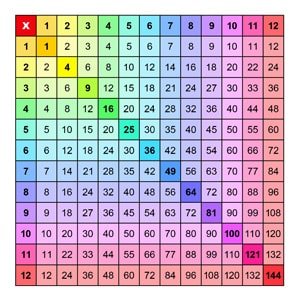

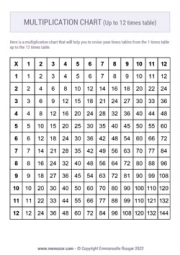
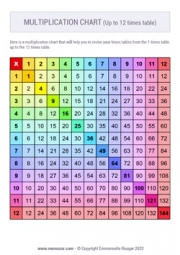

















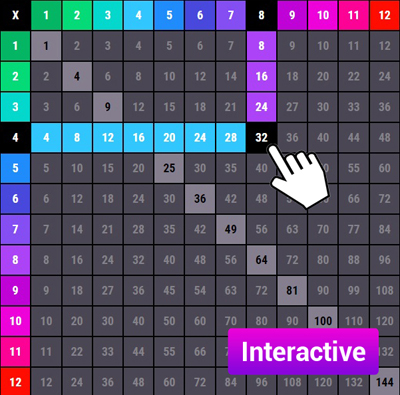




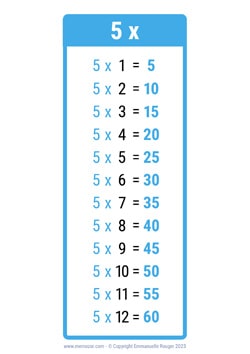

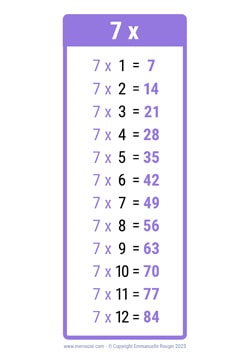





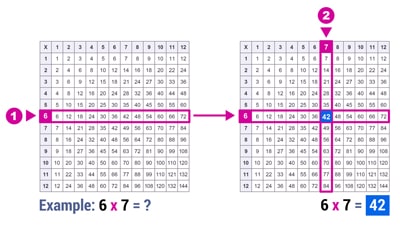





 The diagonal or Square numbers
The diagonal or Square numbers Coloring a multiplication Chart
Coloring a multiplication Chart Number of results in a multiplication Chart
Number of results in a multiplication Chart Number of results without duplicates
Number of results without duplicates Real number of results to learn
Real number of results to learn Real number of results to learn in a multiplication chart 1-12
Real number of results to learn in a multiplication chart 1-12
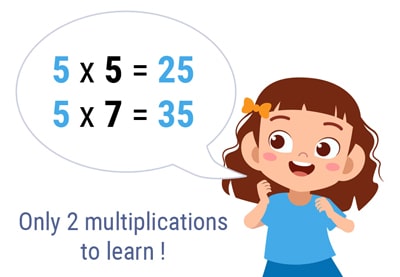

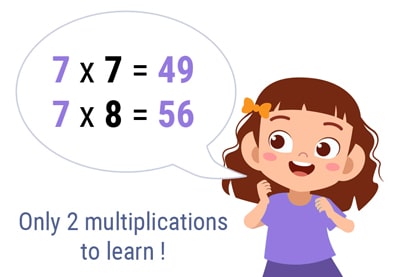




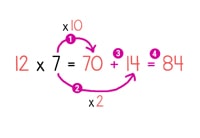
 Times tables games
Times tables games Online multiplication tables exercises
Online multiplication tables exercises Use multiplication Flash cards
Use multiplication Flash cards Fill in a Blank multiplication Chart
Fill in a Blank multiplication Chart Printable multiplication Worksheets
Printable multiplication Worksheets
